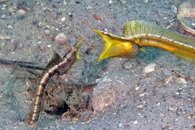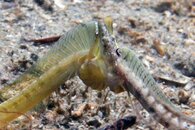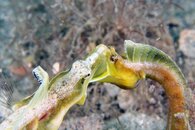You are using an out of date browser. It may not display this or other websites correctly.
You should upgrade or use an alternative browser.
You should upgrade or use an alternative browser.
Pikeblenny type
- Thread starter mntlblok
- Start date
Please register or login
Welcome to ScubaBoard, the world's largest scuba diving community. Registration is not required to read the forums, but we encourage you to join. Joining has its benefits and enables you to participate in the discussions.
Benefits of registering include
- Ability to post and comment on topics and discussions.
- A Free photo gallery to share your dive photos with the world.
- You can make this box go away
designbysue
Contributor
That is SOOOO cool! I can't wait to dive again. (Don't know what they are but just love the pics)
Sue
Sue
Sully3
Contributor
it actually looks like you got both species in the first shot which is awesome btw
mntlblok
Contributor
Pikeblenny Land
When I was first introduced to this "colony" back in March, there was the guy on the right in the third pic and a nearby female. He's intermediate in size (and color) to the other two males. She just sat there in her tube, while the "showoff" repeatedly displayed, but was shy if I got close to him with the camera rig.
Next trip in May, the showoff was still there, but much less shy, with the female pretty much the same five or six feet away as before. Whilst continuing to try to catch him in focus in his displays, suddenly there were two of them in my viewfinder and I about fell over. Hadn't seen the second, larger (and paler) male prior to this.
Things kind of run together in my memory now, but I did make two trips back in June and continued to find the showoff and various combinations of others in the vicinity. The middle pic is actually of the paler, larger male and the female. Both had been out swimming free at various times and I happened to be able to follow them for some time and catch their "greeting". They spent a fair bit of time hanging out loose in the same vicinity. The big guy did a *lot* of swimming around, covering large areas, occasionally backing into unoccupied holes. His "main" hole was at least twenty five feet from where the others hung out. (Turns out this was also during the May trip).
On the second trip in June I found *three* males - the darker, smaller one about two feet from the large, pale one, and both about six feet from the "showoff" (who was always in same spot). The little dark one was more inclined to display than the large pale one, but neither ever displayed nearly as much as the showoff. I was able to see the large one leave his tube and head over toward the poor little dark, shy one. Just as he had done with the showoff in that first encounter, after the "gaping" greeting, the smaller guy backed back down into his hole, followed by the big, pale guy backing in over the top of him. As with the first "fight", he stayed there for less than a minute with his head sticking out before swimming back to his own hole. Was a little surprised to then see the little dark guy soon displaying, again.
I can sit and watch these guys for hours - and have. On this trip, with the three males in proximity, I finally found a female hanging out in the grassy area near the showoff, within two feet of him, on the opposite side from the other two males. This area - the size of a large room in a house - had *lots* of other interesting life, much of it remaining in the same general area for weeks and weeks, with the sand and bottom "trash" varying a good bit. On my last trip, about a week ago, the landscape there was nearly totally flattened out with sand and I was able to find very little life evident. Amazing transition. Seasonal?
On this trip, with the three males in proximity, I finally found a female hanging out in the grassy area near the showoff, within two feet of him, on the opposite side from the other two males. This area - the size of a large room in a house - had *lots* of other interesting life, much of it remaining in the same general area for weeks and weeks, with the sand and bottom "trash" varying a good bit. On my last trip, about a week ago, the landscape there was nearly totally flattened out with sand and I was able to find very little life evident. Amazing transition. Seasonal?
Maybe I can get invited to blenny week some day. But, it would be nice to be able to learn to accurately identify them. . .
But, it would be nice to be able to learn to accurately identify them. . .
Kevin
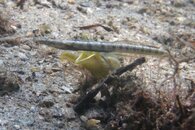
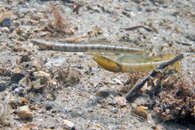
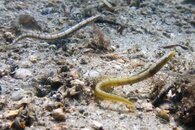
it actually looks like you got both species in the first shot
When I was first introduced to this "colony" back in March, there was the guy on the right in the third pic and a nearby female. He's intermediate in size (and color) to the other two males. She just sat there in her tube, while the "showoff" repeatedly displayed, but was shy if I got close to him with the camera rig.
Next trip in May, the showoff was still there, but much less shy, with the female pretty much the same five or six feet away as before. Whilst continuing to try to catch him in focus in his displays, suddenly there were two of them in my viewfinder and I about fell over. Hadn't seen the second, larger (and paler) male prior to this.
Things kind of run together in my memory now, but I did make two trips back in June and continued to find the showoff and various combinations of others in the vicinity. The middle pic is actually of the paler, larger male and the female. Both had been out swimming free at various times and I happened to be able to follow them for some time and catch their "greeting". They spent a fair bit of time hanging out loose in the same vicinity. The big guy did a *lot* of swimming around, covering large areas, occasionally backing into unoccupied holes. His "main" hole was at least twenty five feet from where the others hung out. (Turns out this was also during the May trip).
On the second trip in June I found *three* males - the darker, smaller one about two feet from the large, pale one, and both about six feet from the "showoff" (who was always in same spot). The little dark one was more inclined to display than the large pale one, but neither ever displayed nearly as much as the showoff. I was able to see the large one leave his tube and head over toward the poor little dark, shy one. Just as he had done with the showoff in that first encounter, after the "gaping" greeting, the smaller guy backed back down into his hole, followed by the big, pale guy backing in over the top of him. As with the first "fight", he stayed there for less than a minute with his head sticking out before swimming back to his own hole. Was a little surprised to then see the little dark guy soon displaying, again.
I can sit and watch these guys for hours - and have.
Maybe I can get invited to blenny week some day.
Kevin



Similar threads
- Replies
- 12
- Views
- 1,157
- Replies
- 23
- Views
- 2,680
- Replies
- 10
- Views
- 1,322
- Replies
- 5
- Views
- 742



